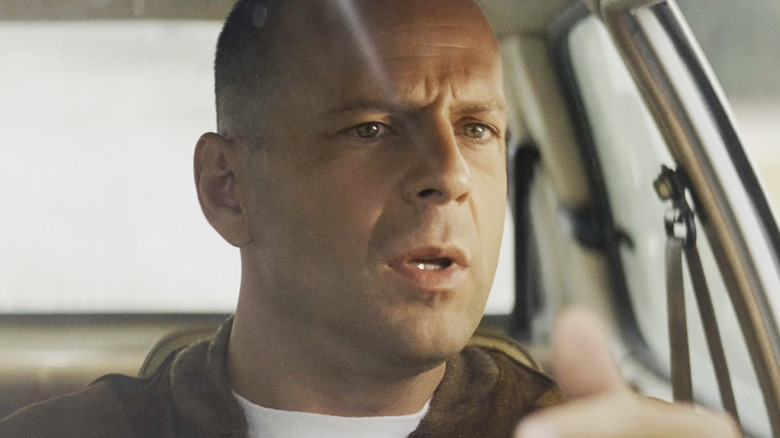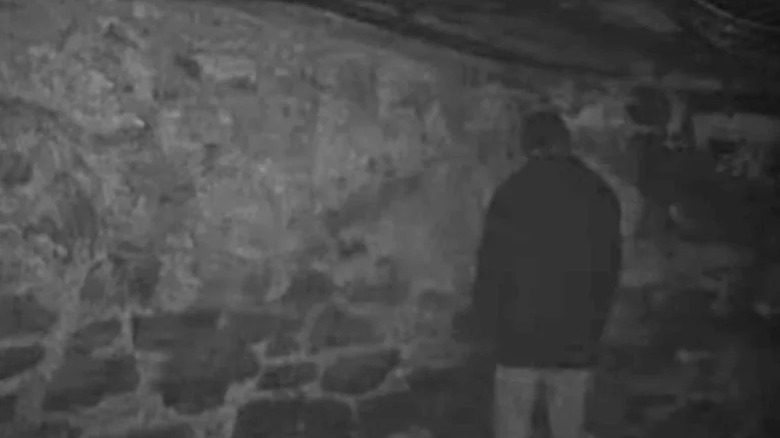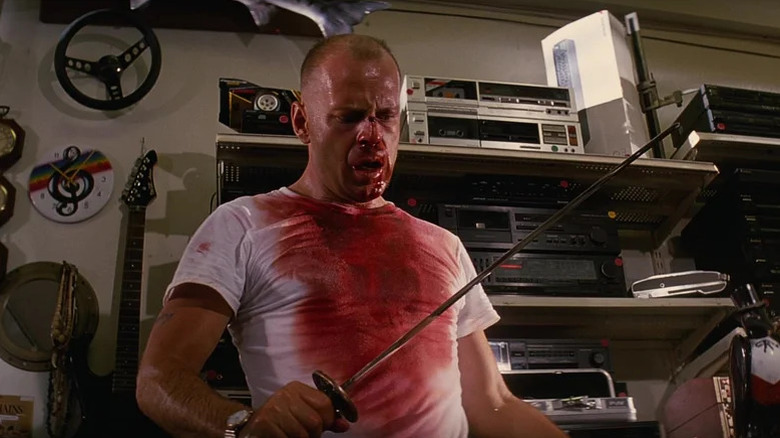Bruce Willis Predicted One Of The Biggest Horror Movies Of All Time On The Set Of Pulp Fiction
What does "Pulp Fiction" have to do with low-budget horror movies? Well, the film's $8 million budget might seem like a fairly significant amount of money, but it's not the kind of figure you'd expect for a film starring Samuel L. Jackson, John Travolta, and Uma Thurman. Of course, at the time those actors weren't the bonafide megastars they'd become, or, in Travolta's case, king of the 0% Rotten Tomatoes score (sorry John, you're a legend). Still, $8 million is more the kind of budget you'd expect for a mid-range horror movie, so it's impressive Quentin Tarantino managed to make $212 million from his off-beat postmodern pastiche.
That's not the only connection between "Pulp Fiction" and horror, either. Aside from the film's often striking depictions of violence, there's a surprising link between one of its stars and an ultra low-budget horror movie that debuted the same decade as Tarantino's film.
Bruce Willis made "Pulp Fiction" profitable before shooting even began, simply by agreeing to appear in the film and bringing his well-established movie star gravitas to the film and not demanding a huge payday for the effort. The actor didn't have a big part in Tarantino's celebrated opus, but as boxer Butch Coolidge, Willis reminded audiences that he more than deserved his star status following a few box office failures. As it turns out, the "Die Hard" star also made a prediction on the set of "Pulp Fiction" that proved to be so oddly accurate it's almost as disturbing as any of the violence therein.
Bruce Willis successfully predicts a modern horror classic
Posted by filmmaker Scott Derrickson on Twitter/X, a clip shows Bruce Willis speaking to Quentin Tarantino, who's holding the camera, on the set of "Pulp Fiction" and making some eerily accurate predictions about the future of filmmaking. "Some day in the next five years," he says, "Someone's gonna take one of these [camcorders] and make a feature film with it." The actor went on to lay out a scenario whereby low-budget, lo-fi filmmaking becomes the norm:
"Some kid, some 17-year-old kid, is gonna make this killer, drop-dead, poorly-lit video movie that is gonna be the hippest f***ing thing. And then there's gonna be hundreds of them everywhere. And they're gonna cost about $60,000."
Now, "Pulp Fiction" was released in 1994 and five years later, in 1999, we saw the release of the movie Willis apparently foresaw in a vision: "The Blair Witch Project." This legendary low-budget horror film, shot on a Hi8 camcorder, kick-started the found footage trend and became a cultural sensation thanks in part to a genius marketing strategy that promoted the movie as if it were actual found footage of real events.
Admittedly, directors Daniel Myrick and Eduardo Sánchez were not 17-year-old kids when they made "Blair Witch," and did, in fact, shoot the film during their mid-30s. But that's about the only thing Willis got wrong in his prediction. Five year timespan? Check. "Poorly-lit video movie?" Check. (Just take a look at the infamous final shot of "Blair Witch.") And guess how much "The Blair Witch Project" was made for? $60,000. Or, at least between $35,000 and $60,000.
Bruce Willis' prediction was a little too accurate
After "The Blair Witch Project" was picked up for distribution, the final budget grew considerably prior to the film's premiere at the 1999 Sundance Film Festival. Reportedly, a sound remix and 35mm transfer saw the final budget grow to around $600,000. But with a global box office take of $248 million, that increase from $60,000 to $600,000 turned out to be negligible. What's important here, though, is not what distributors Artisan Entertainment made from "The Blair Witch" or that the movie became one of the most successful independent films of all time, but that Bruce Willis apparently possesses supernatural abilities of his own.
Willis' comments are especially impressive considering his claim that the first low-budget camcorder film would spawn "hundreds" like it, which is exactly what has happened in the wake of "Blair Witch." Found footage is now, itself, a well-established genre, with numerous films taking their cues from Daniel Myrick and Eduardo Sánchez's modest production. It's a lineage that includes such celebrated efforts as Oren Peli's 2007 horror flick "Paranormal Activity" and Matt Reeves' 2008 monster horror feature "Cloverfield" — two of the scariest found footage horror movies ever made. Of course, you could make the point that this genre dates all the way back to films like 1980's "Cannibal Holocaust" or even earlier than that, but "Blair Witch" was the first time such a low-budget film that embraced the lo-fi nature of its filmmaking equipment received such widespread acclaim and attention.
Even today, you can see the influence of "Blair Witch." Take something like "Skinamarink," one of the scariest horror films of 2023. Kyle Edward Ball's film was made on a budget of just $15,000 and shot in the director's childhood home. With its embrace of lo-fi aesthetics and its modest production, it feels very much part of the legacy of "Blair Witch" and shows that Willis' prediction rings true all the way to our present day.
Not that Quentin Tarantino has struggled in any sense since he made "Pulp Fiction," then, but when Willis tells the director at the beginning of the clip in question, "You should be the first guy to do this," Tarantino might have done well to have listened.


